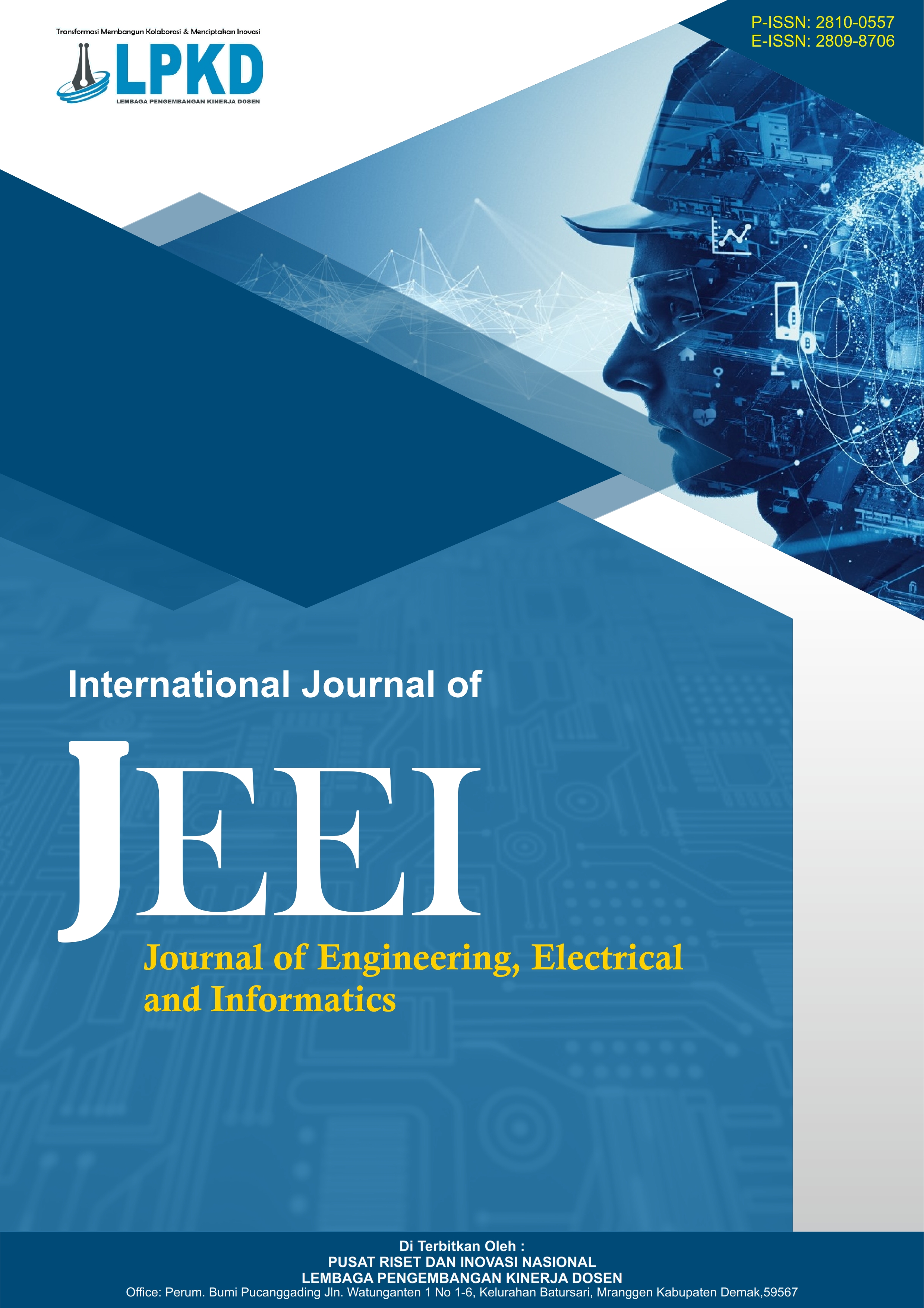Predicting Quality of Service on Cellular Networks Using Artificial Intelligence
DOI:
https://doi.org/10.55606/jeei.v5i2.3901Keywords:
Artificial Intelligence, Cellular Network, Predictions, Quality of ServiceAbstract
The purpose of this research is to explore the application of artificial intelligence (AI) techniques, particularly Machine Learning, in predicting quality of service (QoS) on mobile networks, with the main focus being to test the ability of AI models to predict several QoS parameters, involving several important stages that reflect best practices in the development of artificial intelligence (AI)-based predictive systems for mobile networks. The dataset used in this study consists of data collected from simulations of mobile networks with various load and latency conditions. The parameters measured include Throughput, Latency and Packet Loss. Model evaluation was carried out to measure prediction performance using Mean Absolute Error (MAE), Root Mean Square Error (RMSE), and Mean Absolute Percentage Error (MAPE) measurements. The AI models used include machine learning algorithms consisting of K-Nearest Neighbors (KNN) for classification and regression on QoS datasets, Support Vector Machine (SVM) to model non-linear relationships between QoS parameters and input variables, and Deep Learning (LSTM=Long Short-Term Memory) used to predict QoS based on time sequence data. This study found that LSTM-based deep learning models have the lowest prediction error rate in estimating packet loss, so they can provide the most accurate results in predicting QoS on mobile networks. This approach is capable of handling data that is sequential and has significant time dependence, making it more suitable for dynamic mobile network applications.
References
Almeida, A., Rito, P., Brás, S., Pinto, F. C., and Sargento, S., "A machine learning approach to forecast 5G metrics in a commercial and operational 5G platform: 5G and mobility," Computer Communications, vol. 228, 2024. [Online]. Available: https://doi.org/10.1016/j.comcom.2024.107974
Al-Thaedan, A., Shakir, Z., Mjhool, A. Y., Alsabah, R., Al-Sabbagh, A., Nembhard, F., and Salah, M., "A machine learning framework for predicting downlink throughput in 4G-LTE/5G cellular networks," International Journal of Information Technology, vol. 16, no. 2, pp. 651–657, 2024. [Online]. Available: https://doi.org/10.1007/s41870-023-01678-w
Bikkasani, D. C., and Yerabolu, M. R., "AI-driven 5G network optimization: A comprehensive review of resource allocation, traffic management, and dynamic network slicing," American Journal of Artificial Intelligence, vol. 8, no. 2, 2024. [Online]. Available: https://doi.org/10.11648/j.ajai.20240802.14
Dong, R., She, C., Hardjawana, W., Li, Y., and Vucetic, B., "Deep learning for radio resource allocation with diverse quality-of-service requirements in 5G," IEEE Access, 2020. [Online]. Available: https://doi.org/10.48550/arXiv.2004.00507
Ghanem, H., Samarah, S., and Mahmoud, Q. H., "DISTINQT: A distributed privacy-aware learning framework for QoS prediction in future mobile and wireless networks," arXiv preprint, 2024. [Online]. Available: https://arxiv.org/abs/2401.10158
Stigenberg, J., Saxena, V., Tayamon, S., and Ghadimi, E., "QoS-aware scheduling in New Radio using deep reinforcement learning," in Proc. IEEE 32nd Annu. Int. Symp. Personal, Indoor and Mobile Radio Communications (PIMRC), 2021, pp. 991–997. [Online]. Available: https://doi.org/10.1109/PIMRC50174.2021
Mhatre, S., Adelantado, F., Ramantas, K., and Verikoukis, C., "Intelligent QoS aware slice resource allocation with user association parameterization for beyond 5G ORAN based architecture using DRL," Journal of Class Files, 2023. [Online]. Available: https://doi.org/10.48550/arXiv.2311.01594
Palaios, A. et al., "Machine learning for QoS prediction in vehicular communication: Challenges and solution approaches," IEEE Access, vol. 11, pp. 92459–92477, 2023. [Online]. Available: https://doi.org/10.1109/ACCESS.2023.3303528
Sliwa, B., Schippers, H., and Wietfeld, C., "Machine learning-enabled data rate prediction for 5G NSA vehicle-to-cloud communications," in Proc. IEEE 4th 5G World Forum, 2021. [Online]. Available: https://doi.org/10.48550/arXiv.2109.04117
Srinivasa Gowda, G. K. S., and Panchaxari, "Artificial intelligence in enhancing Quality of Service (QoS) in 5G networks: A comprehensive review," International Journal on Recent and Innovation Trends in Computing and Communication, vol. 11, no. 1, pp. 336–340, 2024.
Xu, D., Xiong, Q., Qin, Z., and Ni, J., "Deep learning for radio resource allocation with diverse QoS requirements in 5G," arXiv preprint, 2020. [Online]. Available: https://arxiv.org/abs/2004.00507
Yin, H., Guo, X., Liu, P., Hei, X., and Gao, Y., "Predicting channel quality indicators for 5G downlink scheduling in a deep learning approach," IEEE Access, 2020. [Online]. Available: https://doi.org/10.48550/arXiv.2008.01000
Yuan, X., Yao, H., Wang, J., Mai, T., and Guizani, M., "Artificial intelligence empowered QoS-oriented network association for next-generation mobile networks," IEEE Transactions on Cognitive Communications and Networking, vol. 7, no. 3, pp. 856–870, 2021. [Online]. Available: https://doi.org/10.1109/TCCN.2021.3065463
Zhang, H., Wang, D., Zhang, W., Tan, L., Kibalya, G., Zhang, P., and Igorevich, K. K., "QoS prediction in intelligent edge computing based on feature learning," Journal of Cloud Computing: Advances, Systems and Applications, 2023. [Online]. Available: https://doi.org/10.1186/s13677-023-00391-0



.png)
.png)


